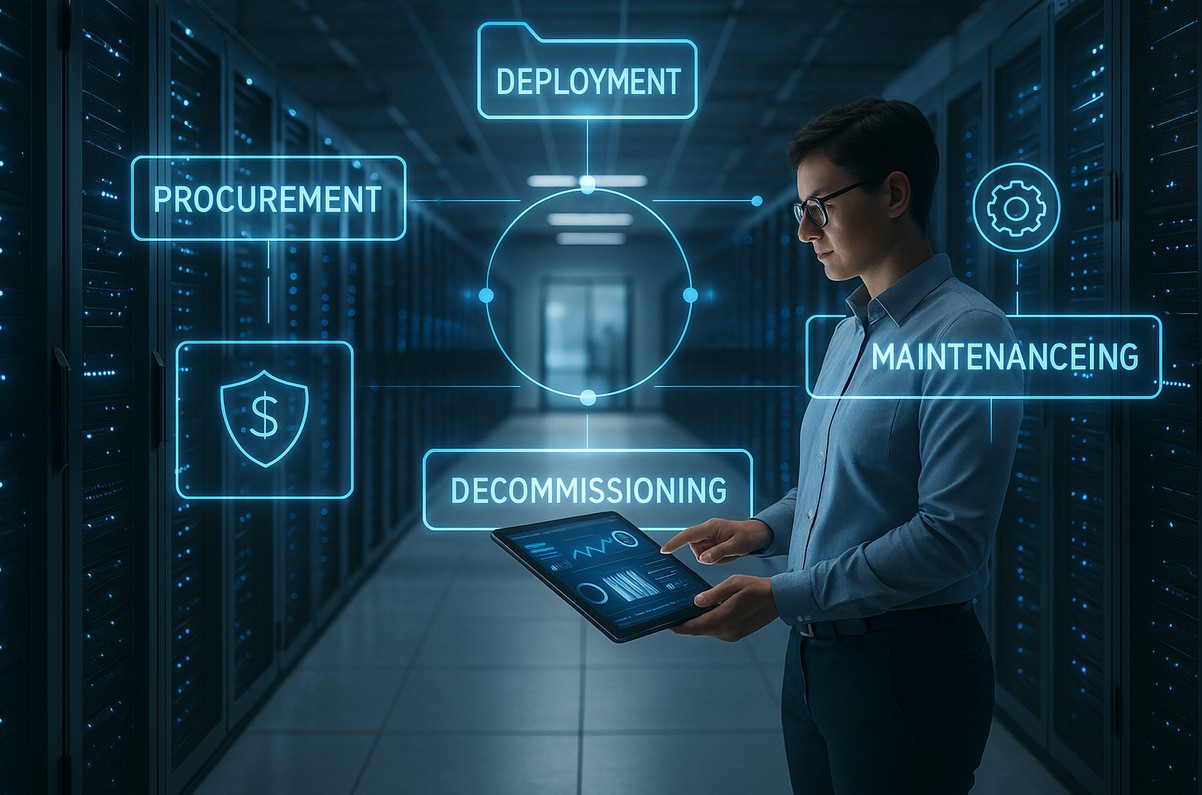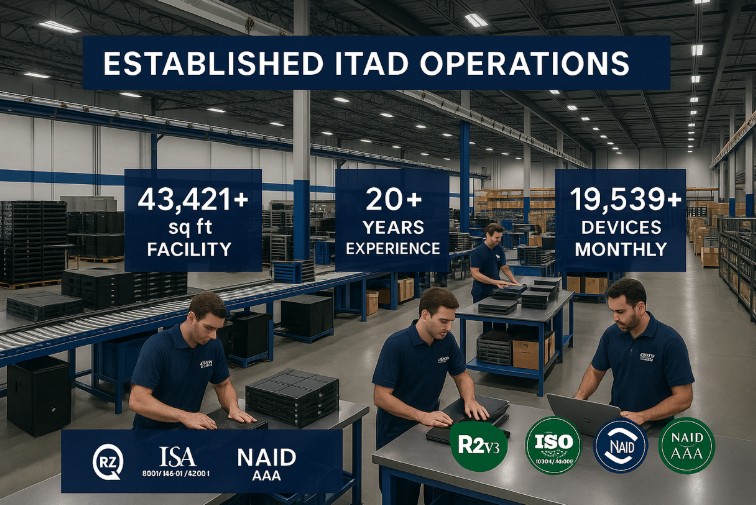Is your IT infrastructure ready for tomorrow’s technological demands, or is it silently drifting towards obsolescence, escalating costs, and cybersecurity risks? Effective IT Lifecycle Management (ITLM) isn’t just about staying current—it’s about staying ahead. Forward-thinking organizations understand that strategic lifecycle management is an operational necessity that ensures sustainability, efficiency, and competitive advantage.
Understanding IT Lifecycle Management
IT Lifecycle Management involves the strategic planning, proactive oversight, and timely refreshing of IT assets, including both hardware and software.
- It reduces maintenance costs, minimizes downtime, strengthens security, and improves overall system performance.
- According to Gartner, disciplined IT Asset Lifecycle Management can yield up to 30% initial cost savings, with at least 5% in annual savings thereafter.
ITLM spans every phase of an asset’s life from planning and procurement through deployment, day-to-day use, and eventual decommissioning. A comprehensive lifecycle strategy ensures that each stage contributes to productivity, data security, and cost control. In an era of rapid innovation and shifting compliance requirements, organizations must regularly assess and optimize their IT infrastructure to stay resilient and competitive.
Aligning Hardware Refresh Cycles with IT Infrastructure Goals
Keeping hardware refresh cycles aligned with infrastructure management goals is essential to maintain performance, mitigate risks, and ensure IT efficiency. Regular refreshes:
- Prevent performance slowdowns.
- Minimize vulnerabilities such as data breaches.
- Enhance user productivity and satisfaction.
Failing to refresh hardware can lead to maintenance costs that exceed 50% of total IT budgets.
An effective refresh policy should be integrated with asset tracking systems and tied to performance-based triggers. These cycles are influenced by factors such as:
- Device performance and energy efficiency
- Firmware and vendor support
- Usage data and operational analytics
When designing refresh timelines, enterprises must also consider workload demands, support resources, application compatibility, and internal support resources.
How to Plan a Successful IT Hardware Refresh Strategy
- Clearly define IT infrastructure goals and allocate IT budgets effectively.
- Schedule refresh cycles in alignment with emerging technology trends.
- Mitigate security threats, minimize downtime, and reduce compliance risks.
A successful refresh starts with evaluating current IT equipment, reviewing software licenses, and assessing future scalability needs. Incorporating configuration audits and usage analytics supports informed decision-making.
Partnering with lifecycle experts for vulnerability assessments, patch management reviews, and capacity planning improves refresh outcomes and minimizes post-deployment disruptions.
Proactive IT Asset Management for Security and Lifecycle Efficiency
- Enforce comprehensive lifecycle policies, including secure data migration protocols.
- Ensure legacy systems and IT equipment are securely decommissioned
- Safeguard operations against security gaps, compliance violations, and unplanned downtime.
Proactive asset management enables a real-time view of all IT assets through practices like:
- Asset tagging and lifecycle tracking
- Performance monitoring and predictive maintenance.
This visibility empowers IT teams to make timely decisions, avoid costly emergency replacements, and maintain operational continuity that disrupts workflows and budgets.
Choosing the Right IT Lifecycle Management Partners
Choosing suitable technology partners, such as OEMSource, is essential for effective enterprise lifecycle management. The right partner adds value far beyond procurement and delivery by supporting:
- Long-term asset value optimization.
- Regulatory and environmental responsibility.
- End-to-end lifecycle execution.
Look for providers that offer:
- Full-spectrum lifecycle services: procurement, deployment, reverse logistics, tech refresh, remarketing, and sustainable recycling
- Secure boot capabilities and UL-tested hardware authenticity
- Global supply chain resilience and transparency
Understanding the Key Stages of IT Lifecycle Management
Each stage of the IT lifecycle plays a critical role in operational efficiency and long-term success:
- Procurement: Hardware acquisition aligned with lifecycle stages and IT asset management goals.
- Deployment: Secure, efficient implementation designed to minimize business disruption.
- Use: Ongoing maintenance, performance monitoring, and user support.
- Upgrade: Timely updates based on metrics, patch schedules, and manufacturer support cycles.
- Refresh: Scheduled device replacement that ensures operational continuity and performance.
Understanding these stages supports precise budgeting, timely data migration, and strategic resource allocation. When each step is well-managed, organizations benefit from stronger endpoint protection, less downtime, and improved cost efficiency.
How to Optimize IT Operations and Reduce Security Risks
To stay secure and resilient, organizations must proactively address infrastructure vulnerabilities. This includes conducting vulnerability assessments, maintaining disaster recovery plans, and keeping firmware up to date.
According to IBM’s Data Breach Report, the average data breach now costs nearly $5 million, highlighting the escalating risk of unpatched systems and the AI-driven threats.
The longer hardware remains in use beyond its intended lifecycle, the more likely it is to suffer from unsupported drivers, outdated software, and exposed security gaps. IT leaders should implement patch automation, secure decommissioning protocols, and maintain audit trails to ensure visibility and protection throughout the asset lifecycle.
Top tools for IT Lifecycle Management and Asset Optimization
Leveraging the right technology lifecycle management tools empowers organizations to improve oversight and performance:
- Use advanced IT asset management platforms to track device health, warranties, and replacement schedules.
- Apply predictive analytics and usage analytics to make smarter refresh and upgrade decisions.
- Reduce IT support calls and enhance digital employee experiences with real-time monitoring.
Popular tools include configuration management databases (CMDBs) and mobile device management (MDM) solutions. These platforms offer end-to-end visibility across software and hardware assets, supporting compliance, improving return on investment (ROI), and streamlining decision-making across the IT lifecycle..
Best Practices for Continuous IT Lifecycle Optimization
Ongoing success in IT Lifecycle Management requires continuous evaluation and improvement. Core strategies include:
- Conducting regular configuration audits and maintaining accurate CMDB records
- Using performance monitoring data to guide software updates and hardware refresh cycles
- Leveraging internal feedback and analytics to refine lifecycle processes.
Successful ITLM programs are iterative. By analyzing end-user computing insights and historical performance, organizations can refine procurement strategies, adjust refresh timelines, and optimize software deployment. Agility is key effective programs evolve alongside business needs and compliance demands.
How Automation Enhances IT Lifecycle Management
Automation minimizes human errors, lowers support costs, and standardizes IT operations at scale. Features such as secure boot protocols, automated patching, and MDM tools improve operational efficiency and device performance.
Additionally, automation tools can streamline onboarding and offboarding, help manage software licenses more efficiently, and reduce risk exposure during the refresh process. Tools that integrate AI for predictive analytics further enhance visibility and control.
Why Cross-Functional Collaboration Improves IT Asset Management
Successful IT lifecycle strategies depend on alignment across departments. Encourage transparent communication between IT, procurement, security, HR, and leadership teams.
Best practices for collaboration include:
- Clearly communicating lifecycle policies, security protocols, and refresh schedules
- Involving HR in secure device offboarding and access control
- Partnering with finance to align IT budgets with asset depreciation and refresh timelines
Unified efforts reduce friction, strengthen compliance, and help prevent costly oversights in device handling and data security.
How to Build Sustainability Into Refresh Strategies
Sustainable refresh practices reduce environmental impact and support ESG goals. Responsible IT asset disposition, including the recycling of lithium batteries, plastics, and motherboards, improves energy efficiency and reduces e-waste.
Modern refresh programs should also track:
- Carbon footprint metrics for end-of-life equipment
- Device reclamation rates
- Partnerships with certified recyclers and ITAD vendors
These initiatives strengthen corporate social responsibility efforts while supporting long-term environmental and operational goals.
Meeting Compliance and Security Standards in IT Asset Management
Compliance and security are non-negotiable in industries like healthcare, finance, and government. Organizations must:
- Prioritize compliance standards.
- Enforce data destruction and frequent patching.
- Maintain policy documentation to support audit readiness.
Industries such as healthcare, finance, and government face strict compliance demands around data security, device tracking, and end-of-life management. Failing to meet these standards can lead to audits, fines, and reputational damage.
Future-Proofing IT Infrastructure Through Strategic Lifecycle Management
Future-proofing your IT infrastructure means embracing scalable technologies and modernizing operations to stay ahead of evolving demands. Solutions like cloud computing, hybrid infrastructure models, and cloud-based storage enable seamless management of enterprise servers, network devices, and data centers, reducing downtime and supporting continuous business operations.
Organizations should also monitor advancements such as SSD storage, edge computing, and performance-based hardware refresh models based on Moore’s Law predictions. Staying current with industry innovation ensures the organization is never left behind.
By strategically managing your IT lifecycle and partnering with experts like OEMSource, your organization can proactively adapt to future technology demands while enhancing resilience, performance, and long-term competitive advantage.
Frequently Asked Questions
Why is IT lifecycle management important?
IT lifecycle management ensures cost-efficiency, security, compliance, and business continuity by proactively managing assets from procurement through decommissioning.
How often should IT hardware be refreshed?
Most organizations refresh IT hardware every 3-5 years, depending on device performance, support costs, and technology advancements.
What risks are associated with outdated IT infrastructure?
Outdated infrastructure increases vulnerability to security threats, downtime, performance issues, and higher maintenance costs.
How can lifecycle management tools benefit my business?
These tools improve accuracy in asset tracking, reduce operational disruptions, enhance cybersecurity, and provide actionable insights into IT asset usage and performance.
What role does sustainability play in IT lifecycle management?
Sustainability IT practices reduce environmental impact and help organizations meet ESG commitments, improving brand reputation and regulatory compliance.





